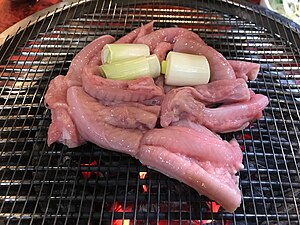Cookbook:Hagfish
| Hagfish | |
|---|---|
 | |
| Category | Seafood |
Cookbook | Recipes | Ingredients | Equipment | Techniques | Cookbook Disambiguation Pages | Ingredients
Hagfish are a variety of fish uncommonly used as food.
Characteristics
editHagfish are chewy, with a softer spinal cord that runs through their back, and have a mild taste.
Selection and storage
editIt is difficult to source hagfish outside of Korea, though they may be found in California (where they are fished and usually shipped to Korea).
Use
editThe fish are primarily eaten in Korea.[1] To prepare them, they are sliced down the middle to remove the digestive tract, then marinated in a sauce used for Korean barbecue.[1] Traditionally, the raw fish are then placed on a heated plate at the center of the table, where they are cooked and served like galbi, using scissors to slice the hagfish up.
Recipes
editReferences
edit- ↑ a b dfg.webmaster@alaska.gov. "Hagfish Uses, Alaska Department of Fish and Game". www.adfg.alaska.gov. Retrieved 2024-10-13.